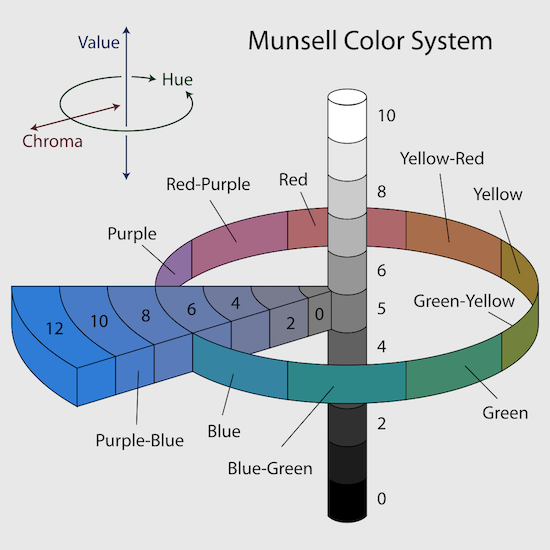🌈 Soil Colour
Hue, Value, Chroma
- Soil colour indicates many soil features. A change in soil colour from the adjacent soils indicates a difference in the soil’s mineral origin (parent material) or in the soil development.
- Soil colour varies among different kinds as well as within the soil profile of the same kind of soil. It is an important soil properties through which its description and classification can be made. Soil colour directly influence soil temperature.
Kinds of soil colour
- Soil colour is inherited from its parent material and that is referred to as lithochromic, e.g. red soils developed from red sandstone.
- Besides soil colour also develops during soil formation through different soil forming processes and that is referred to as acquired or pedochromic colour, e.g. red soils developed from granite or schist.
Factors affecting soil colour
👉🏻 There are various factors or soil constituents that influence the soil colour which are as follows:
- Organic matter: soils containing high amount of organic matter show the colour variation from black to dark brown.
- Iron compounds: soil containing higher amount of iron compounds generally impart red, brown and yellow tinge colour.
- Silica, lime and other salts: Sometimes soils contain either large amounts of silica and lime or both. Due to presence of such materials in the soil the colour of the soil appears like white or light coloured.
- Mixture of organic matter and iron oxides: Very often soils contain a certain amount of organic matter and iron oxides. As a result of their existence in soil, the most common soil colour is found and known as brown.
- Alternate wetting and drying condition: During monsoon period due to heavy rain the reduction of soil occurs and during dry period the oxidation of soil also takes place due to development of such alternating oxidation and reduction condition, the colour of soil in different horizons of the soil profile is variegated or mottled. This mottled colour is due to residual products of this process especially iron and manganese compounds.
- Oxidation-reduction conditions: when soils are waterlogged for a longer period, the permanent reduced condition will develop. The presence of ferrous compounds resulting from the reducing condition in waterlogged soils impart bluish and greenish colour. Therefore, it may be concluded that soil colour indirectly indicative of many other important soil properties, besides soil colour directly modify the soil temperature e.g. dark coloured soils absorb more heat than light coloured soils.
Determination of soil colour
- The soil colours are best determined by the comparison with the
Munsell colour. This colour chart is commonly used for this purpose. - The colour of the soil is a result of the light reflected from the soil.

👉🏻 Soil colour rotation is divided into three parts:
- Hue: It denotes the
dominant spectral colour(Red, Yellow, Blue and Green). - Value: It denotes the
lightness or darknessof a colour (the amount of reflected light). - Chroma: It represents the
purity of the colour(strength of the colour). - The Munsell colour notations are systematic numerical and letter designations of each of these three variables (Hue, Value and Chroma).
- For example, the numerical notation 2.5 YR 5/6 suggests a hue of 2.5 YR, value of 5 and chroma of 6. The equivalent or parallel soil colour name for this Munsell notation is
red.
- Soil colour indicates many soil features. A change in soil colour from the adjacent soils indicates a difference in the soil’s mineral origin (parent material) or in the soil development.
- Soil colour varies among different kinds as well as within the soil profile of the same kind of soil. It is an important soil properties through which its description and classification can be made. Soil colour directly influence soil temperature.
Kinds of soil colour
- Soil colour is inherited from its parent material and that is referred to as lithochromic, e.g. red soils developed from red sandstone.
- Besides soil colour also develops during soil formation through different soil forming processes and that is referred to as acquired or pedochromic colour, e.g. red soils developed from granite or schist. …
Become Successful With AgriDots
Learn the essential skills for getting a seat in the Exam with
🦄 You are a pro member!
Only use this page if purchasing a gift or enterprise account
Plan
Rs
- Unlimited access to PRO courses
- Quizzes with hand-picked meme prizes
- Invite to private Discord chat
- Free Sticker emailed
Lifetime
Rs
1,499
once
- All PRO-tier benefits
- Single payment, lifetime access
- 4,200 bonus xp points
- Next Level
T-shirt shipped worldwide

Yo! You just found a 20% discount using 👉 EASTEREGG

High-quality fitted cotton shirt produced by Next Level Apparel